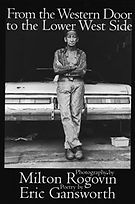Writer & Visual Artist


In this collaboration between two celebrated artists, Native American poet Eric Gansworth has written a book-length cycle of poems that interact with Milton Rogovins photographs to form a unique experience, blending the written word and visual images. The poems and the photographs, taken over a period of forty years, reflect the journey from the Western Door of Seneca reservation culturea culture distinctly differentto the lifestyles of Buffalos Lower West Side.
To view some of the collaborations, go to: http://www.miltonrogovin.com/gansworth.html
World Literatures Today: On the whole, Gansworths poetry adds emotional depth and cultural information to the photographs, and that it does is a testament to the poet because the photographs are compelling objects in their own right. Eric Gansworths poetry and Milton Rogovins photography remind readers that, as Simon Ortiz has said, Indians are everywhere, and it does so honestly, respectfully, and artistically
--Jeanette Calhoun Mish
The Buffalo News: The cross-generational, cross-cultural partnership of Rogovin and Gansworth speaks to all of us as we attempt to reclaim the sense of a living past: a cultural heritage that informs us but doesn't limit us, that affords each of us our individual dignity even as it reminds us how much our stories have in common.
--R.D. Pohl
Buffalo Literature Examiner: From the Western Door to the Lower West Side can only be fully appreciated by witnessing it firsthand, but there are several striking poems that interact with Rogovin's photographs. Sometimes the photos speak stronger, and sometimes the poems bring the subjects across with greater intensity and reality.
For instance, there is a series of photos which follows a couple from early in their relationship through to their marriage. The constant in all of the photos are posters of Jimi Hendrix, above the intimately seated couple in each of the photos. In the first, Hendrix is flanked by nude women, and in the last is a single poster of Hendrix, and Gansworth notes the woman's new wedding ring.
Even more poignant is "Door to Door," in which Gansworth illustrates the transition from the Western Door to the Lower West Side. He describes the splintered wood of the door frame on the reservation juxtaposed with the concrete steps of the Lower West Side. "We will discover that falling on concrete comes with a different price than falling on dirt" (106). The photographs that accompany this poem depict a wooden ramshackle house on the reservation, the family members that live there, and those that have left it behind and now live in the city.
From the Western Door to the Lower West Side is a unique representation of the Native American experience in our region and it offers a glimpse into the past and present of the lives of individuals and of a people that is often forgotten.
--Heather Watt